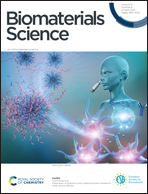Electroconductive and injectable hydrogels based on gelatin and PEDOT:PSS for a minimally invasive approach in nervous tissue regeneration†
Abstract
This work describes the development of electroconductive hydrogels as injectable matrices for neural tissue regeneration by exploiting a biocompatible conductive polymer – poly(3,4-ethylenedioxythiophene)-poly(styrenesulfonate) (PEDOT:PSS) – combined with a biomimetic polymer network made of gelatin. Our approach involved also genipin – a natural cross-linking agent – to promote gelation of gelatin networks embedding PEDOT:PSS. The achieved results suggest that physical–chemical properties of the resulting hydrogels, like impedance, gelation time, mechanical properties, swelling and degradation in physiological conditions, can be finely tuned by the amount of PEDOT:PSS and genipin used in the formulation. Furthermore, the presence of PEDOT:PSS (i) enhances the electrical conductivity, (ii) improves the shear modulus of the resulting hydrogels though (iii) partially impairing their resistance to shear deformation, (iv) reduces gelation time and (v) reduces their swelling ability in physiological medium. Additionally, the resulting electroconductive hydrogels demonstrate enhanced adhesion and growth of primary rat cortical astrocytes. Given the permissive interaction of hydrogels with primary astrocytes, the presented biomimetic, electroconductive and injectable hydrogels display potential applications as minimally invasive systems for neurological therapies and damaged brain tissue repair.



 Please wait while we load your content...
Please wait while we load your content...